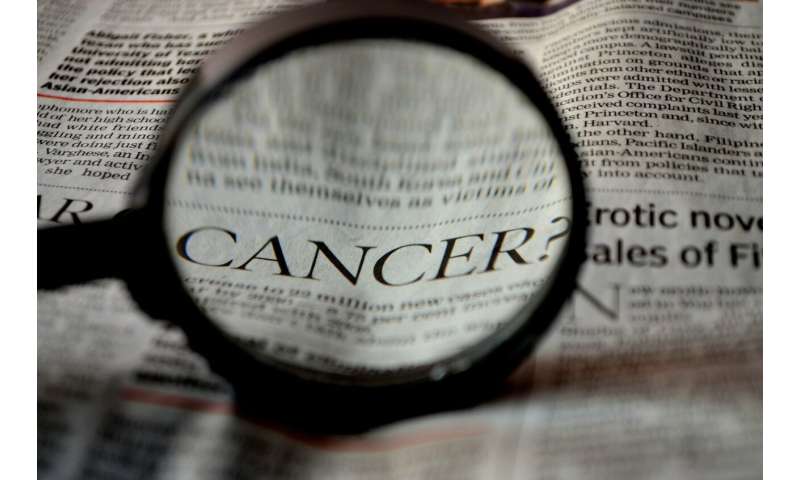A quicker answer on cancer, with waits cut from 84 days to 6

A rapid diagnosis centre has cut waiting times for patients with non-specific symptoms who may have cancer from 84 days to 6, and costs less than current usual care if used at more than 80% of capacity, a new study by Swansea University researchers and NHS colleagues has shown.
Published in the British Journal of General Practice, the study is the first complete analysis of the cost-effectiveness of rapid diagnosis centres (RDCs).
RDCs are now being established within the NHS, building on experience in Denmark. They are aimed at the large number of patients who have vague and non-specific symptoms that could be due to cancer, but who do not meet the criteria for urgent referral.
The researchers evaluated the RDC in Swansea Bay University Health Board (SBUHB), which has been running since June 2017 at Neath Port Talbot Hospital. Patients are referred to the RDC by their GPs.
They are typically seen at the RDC within a week for a morning session where they are reviewed by a multidisciplinary team, examined and given a computerised tomography (CT) scan. They then see a clinician and a Macmillan clinical nurse specialist to discuss and act on the findings.
The research team examined the period from June 2017, when the centre opened, to May 2018. As well as the 189 patients who used the centre, the team also simulated a larger virtual group of 1000 patients, based on real-life data. They compared patients who followed the RDC route with those who were treated in the standard way.
They analysed the costs incurred but also the benefits to patients, using “quality-adjusted life years” (QALYs), the standard NHS measure combining quantity and quality of life.
The researchers found that:
- The average time to a cancer or non-cancer diagnosis, or to discharge from the clinic, was reduced from 84 days in usual care to under 6 days, if the diagnosis is made at the RDC appointment.
- If further investigations are arranged in the RDC, the time to diagnosis is just over 40 days.
- As long as the RDC runs at 80% capacity or over, it is less costly, as well as more effective, than standard clinical practice.
- If the RDC is run at full capacity of 5 patients per session, Swansea Bay University Health Board could save £157,858 and gain 9.2 quality-adjusted life years (QALYs) for every 1,000 patients attending the RDC.
Lead author Dr. Bernadette Sewell, from the Swansea Centre for Health Economics at Swansea University, said:
“Our study shows that rapid diagnosis centres are beneficial for patients and the NHS. They cut waiting times, which means any treatment that people need can start earlier. The longer it takes to diagnose cancer, the worse the outcomes can be for patients and the more expensive it may be for the NHS to treat.
“The key is to ensure that the centres run at least at 80% of capacity, as the RDC in Neath Port Talbot Hospital is now doing.
“Not everyone with cancer displays ‘red flag’ symptoms which indicate the disease and make the patient eligible to be referred to an urgent suspected cancer pathway. As many as one in two might present with vague symptoms, or symptoms which are commonly found in a range of other conditions, such as weight loss, abdominal pain or fatigue.
These patients tend to bounce around the healthcare system, taking longer until a diagnosis can be made, with potentially worsening symptoms, anxiety and costs to the NHS. These previously underserved patients are the people that RDCs can really help by diagnosing or reassuring them quickly and cost-effectively.”
Dr. Heather Wilkes, GP lead of the Swansea Bay University Health Board RDC, says:
“The provision of this service, and the ongoing commitment to it by SBUHB as a diagnostic resource for primary care, has made a massive difference in trying to speedily investigate and care for some of the most difficult cases in our community. It is highly valued by patients and GPs alike and has been established as a permanent service following our evaluation.”
The study was funded by Cancer Research UK.
Andy Glyde, Public Affairs Manager for Cancer Research UK in Wales said:
“This research is exciting because it shows how new ways to diagnose cancer can benefit patients and be cost effective for the NHS. It can be particularly difficult to diagnose patients with symptoms that aren’t specific but still concerning, like loss of appetite or stomach pain. There now needs to be a decision about how this pilot can be integrated into normal practice, including linking up with the Single Cancer Pathway.
Source: Read Full Article


